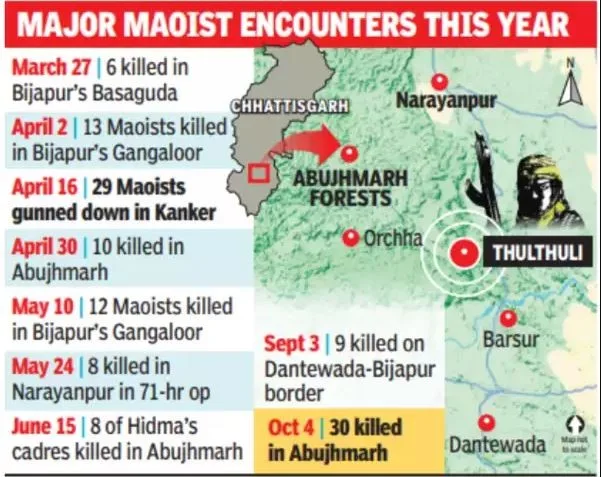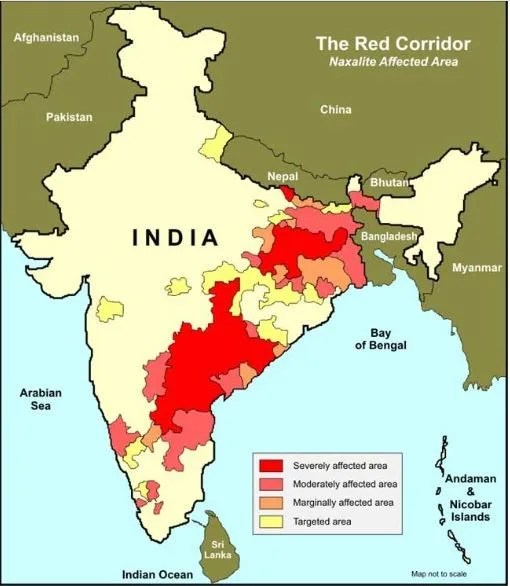Syllabus: GS3/Internal Security
Context
- At least 28 Maoists were killed by security forces in a gunfight in Chhattisgarh’s Bastar region.
About Naxalism
- Naxalism or Left Wing Extremism (LWE) is one of the major challenges to India’s internal security.
- Naxal affected areas in India are known as the ‘Red Corridor’.
- Reason for Naxalism: Naxalites seek to overthrow the State through violent means.
- They openly proclaim lack of faith in the democratic means of ballot and adhere to the violence as a means of achieving their ends.
- Initial Stage: The Naxal movement started with the tribal-peasant uprising against landlords in Naxalbari village of Darjiling district, West Bengal in 1967.

- The uprising was led by leaders such as Charu Majumdar, Kanu Sanyal and Jangal Santhal.
- Communist Party of India (Maoist): In 2004, two main naxal groups, namely the Maoist Communist Centre of India (MCCI) and People’s War merged to form the CPI (Maoist) party.
- Eventually, by 2008 most of the other Naxal groups were merged into CPI (Maoist) which emerged as the umbrella of Naxalite outfits.
- The CPI (Maoist) and all its front organization formations have been included in the list of banned terrorist organizations under the Unlawful Activities (Prevention) Act, 1967.
Presence of Maoists in India
- The States of Chhattisgarh, Jharkhand, Orissa and Bihar are considered severely affected.
- The States of West Bengal, Maharashtra and Andhra Pradesh are considered partially affected. The States of UP and MP are considered slightly affected.
- The CPI(Maoist) are making forays into Southern States of Kerala, Karnataka and Tamil Nadu and planning to link up the Western Ghats to the Eastern Ghats through these states.
- They are attempting incursions into Assam and Arunachal Pradesh, which has serious long-term strategic implications.

Causes of Naxalism
- Marginalisation: Naxalites do not belong to any particular religion, or community, but largely are Dalits, Adivasis and other marginalised sections of society.
- The basic issues are land reforms and economic development. The ideological dimension is provided by Maoism.
- Support Base of Naxalites: Naxalite movement has its support among the landless, share-croppers, agricultural labour, Harijans and tribals.
- As long as these people are exploited and social justice continues to be thwarted, this support base of the Naxalites will continue.
- Forest Management and Livelihood of Tribals: For tribals, forest, land, and water mean their livelihood. They have been deprived of these under various acts and orders which increased the resentment against the authorities.
- Lack of Development: Absence of developmental activities and virtual absence of health care, drinking water, roads, electricity and educational facilities in areas where Naxalism has taken roots.
How Naxalites Possess a Challenge for Country?
- Vulnerability to External Threats: The Maoist movement highlights India‟s interior weaknesses, which makes India also vulnerable to external threats.
- The CPI (Maoist) have close fraternal ties with many North-East insurgent groups.
- Most of these outfits have linkages with external forces hostile to India.
- The CPI (Maoist) have also frequently expressed their solidarity with the J&K terrorist groups.
- Impediments to Economic Development: The Maoists concentrate on the poor and marginalized regions of India, internal order and stability are necessary for a nation‟s economic development.
- Additional Expenses on Internal Security: The Naxalite activities are using up scarce resources on defence and internal security when it should be spent on areas such as social development.
- Adverse Impact on Governance: In the areas under Maoist domination, the absence of governance, which is created by their violent methods in the first place.
- The service delivery systems are extinguished through killing, kidnap, intimidation and extortion.
Government of India’s Approach
- Deployment of the Central Armed Police Forces (CAPFs): Battalions of the CAPFs/Naga Battalions (BNs) are deployed for assisting the State Police in the LWE affected States.
- Security Related Expenditure (SRE) Scheme: Funds are provided for meeting the recurring expenditure relating to insurance, training and operational needs of the security forces, rehabilitation of Left Wing Extremist cadres who surrender, and publicity material to create awareness against violence.
- Review and Monitoring Mechanisms: A number of review and monitoring mechanisms have been put in place by the Government and the Ministry of Home Affairs monitors the situation on a regular basis at various levels.
- Strengthening the Intelligence Gathering Mechanism: Several steps have been taken to strengthen and upgrade the capabilities of intelligence agencies at the Central and State levels.
- These include intelligence sharing through Multi-Agency Centre (MAC) at the Central and State levels, and Multi Agency Centre (SMAC) at the subsidiary level on a 24×7 basis.
- Better Inter-state Coordination: To improve inter-state coordination the government conducts frequent meetings and interactions between the official machinery of the bordering districts of Left Wing Extremism affected States across the country.
- Tackling the challenge of Improvised Explosive Devices (IEDs): IED is the most potent weapon in the hands of Maoists.
- The Union Home Ministry has formulated a Standard Operating Procedure (SOP) on ‘Issues related to Explosives/IEDs/Landmines in naxal affected areas’ and the same has been circulated to the stakeholders for compliance.
- Strengthening of air support: State Governments and the CAPFs have been provided with enhanced air support in terms of UAVs and helicopters for anti-naxal operations, including evacuation of casualties/injured persons.
Way Ahead
- There is a widely accepted view that the Naxal problem can be tackled successfully through a combination of development and security related interventions.
- The problem is not to be viewed entirely as a law and order issue. Often, innocent tribals who live in the interior forest regions fall prey to Naxal intimidation.
- Re-establishing control over Naxalite affected areas, their development, and enabling the marginalized people living there to lead a secure, dignified and better quality of life is vital.
- It is note-worthy that due to the measures initiated by the Government, LWE violence has significantly declined in the last few years.
Source: TH
Next article
News In Short-05-10-2024